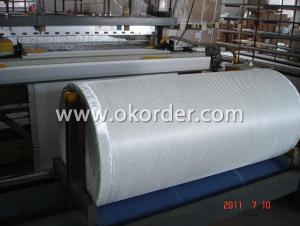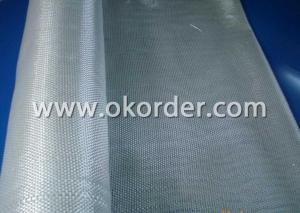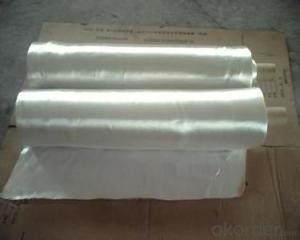Fiberglass Fabrics - High Silica Glass Fiber Cloth Fabric 2024
- Loading Port:
- China Main Port
- Payment Terms:
- TT OR LC
- Min Order Qty:
- -
- Supply Capability:
- -
OKorder Service Pledge
OKorder Financial Service
You Might Also Like
Quick Details
| Place of Origin: | Brand Name: | Model Number: | |||
| Application: | Weight: | Surface Treatment: | |||
| Width: | Weave Type: | Yarn Type: | |||
| Alkali Content: | Standing Temperature: |
Packaging & Delivery
| Packaging Detail: | 50m/carton |
| Delivery Detail: | about 20days |
Specifications
1. High silica glass fiber cloth.
2. High temperature resistance.
3. Instant working temp.: 1400C degree
High Silica Glass Fiber Cloth Suppliers
High Silica Glass Fiber Cloth Description:
1. It is woven by high SiO2 content fiberglass yarn with specially formulated acid treatment.
2. It is a economic silica cloth suitable for continuous use at 1650°F (900°C), and able to withstand short term exposure up to 2200°F (1200°C).
3. Additional polyurethane coating or vermiculite coating will enhance the fabrics unmatched abrasion resistance and tensile strength.
- Q: Can fiberglass fabrics be used for reinforcement in wind turbine blades?
- Certainly! Fiberglass fabrics are capable of reinforcing wind turbine blades. They possess numerous properties that render them appropriate for this purpose. Primarily, they exhibit a high strength-to-weight ratio, enabling them to provide exceptional strength without burdening the blades with excessive weight. This is crucial for wind turbine blades, as they must remain lightweight in order to efficiently harness wind energy. Moreover, fiberglass fabrics display exceptional fatigue resistance, which holds great significance for wind turbine blades due to the constant cyclic loading they experience from wind forces. The ability of fiberglass fabrics to endure repeated stress without deteriorating ensures the longevity and durability of the blades. Furthermore, fiberglass fabrics exhibit commendable dimensional stability, meaning they undergo minimal shrinkage or expansion when exposed to temperature fluctuations or moisture. This property is vital for wind turbine blades, as they must maintain their shape and structural integrity in varying environmental conditions. Additionally, fiberglass fabrics are resistant to corrosion, which proves advantageous for wind turbine blades that face harsh outdoor environments with elevated levels of moisture and salt. The corrosion resistance of fiberglass fabrics safeguards the blades against degradation, thereby enhancing their lifespan. To summarize, fiberglass fabrics encompass a range of properties that render them appropriate for reinforcing wind turbine blades. These properties include a high strength-to-weight ratio, fatigue resistance, dimensional stability, and corrosion resistance. Consequently, wind turbines operate efficiently and endure for longer periods.
- Q: What are the different fiberglass fabric weights for lightweight applications?
- Fiberglass fabric weights for lightweight applications come in various options. These weights are typically measured in ounces per square yard (oz/yd²) and range from very light to slightly heavier. One of the lightest choices is a 3 oz/yd² fiberglass fabric, which finds common usage in applications where weight is critical. This weight is suitable for aerospace components, lightweight structures, and automotive parts. Another weight commonly used for lightweight applications is the 4 oz/yd² fiberglass fabric. It offers a slightly higher level of strength and durability compared to the 3 oz/yd² fabric, while still being lightweight. It is often employed in boat construction, sporting goods, and automotive body panels. For applications demanding more strength and rigidity, a 6 oz/yd² fiberglass fabric may be utilized. This weight remains relatively lightweight but provides a higher level of reinforcement. It is commonly found in wind turbine blades, construction, and marine applications. Lastly, a 9 oz/yd² fiberglass fabric is considered relatively heavy for lightweight applications, but it still falls within the lightweight category. This weight offers greater strength and durability, making it suitable for industrial equipment, tanks, and heavy-duty structures. It is important to note that these weight categories are general guidelines, and the specific requirements of each application may vary. Seeking advice from a fiberglass fabric supplier or manufacturer can give more specific recommendations based on the intended use and desired performance of the lightweight application.
- Q: Can fiberglass fabric be used for reinforcement in power plant tanks?
- Yes, fiberglass fabric can be used for reinforcement in power plant tanks. Fiberglass fabric is a strong and durable material that is commonly used for reinforcement applications in various industries, including power plants. It offers high tensile strength and excellent resistance to corrosion, chemicals, and extreme temperatures. Additionally, fiberglass fabric is lightweight and easy to handle, which makes it a practical choice for reinforcing tanks in power plants. It can help enhance the structural integrity of the tanks, providing additional support and protection against potential leaks or failures.
- Q: How does fiberglass fabric perform in chemical environments?
- Fiberglass fabric is known for its excellent performance in chemical environments. It is highly resistant to a wide range of chemicals, including acids, alkalis, solvents, and oils. The fabric's ability to withstand chemical exposure is primarily due to its composition, which consists of glass fibers that are coated or impregnated with a chemical-resistant resin. The chemical resistance of fiberglass fabric makes it an ideal choice for various applications in industries such as chemical processing, petrochemical, pharmaceutical, and food processing. It can be used in the form of curtains, gaskets, seals, and linings to protect equipment and structures from corrosive chemicals. Furthermore, fiberglass fabric's resistance to chemical exposure also extends to high temperatures. It can withstand continuous operating temperatures of up to 550°C (1022°F) without significant degradation. This property makes it suitable for applications that involve both high-temperature and chemical environments, such as thermal insulation and fire protection systems. In addition to its chemical resistance, fiberglass fabric also offers other beneficial properties. It is lightweight, durable, and has excellent mechanical strength. It is also non-flammable, providing an added layer of safety in chemical environments where fire hazards are a concern. Despite its exceptional performance in chemical environments, it is important to note that fiberglass fabric may still be susceptible to certain highly reactive chemicals or extreme conditions. Therefore, it is crucial to consult with manufacturers or experts to determine the suitability of fiberglass fabric for specific chemical environments and applications.
- Q: Can fiberglass fabric be used for insulation sleeves?
- Yes, fiberglass fabric can be used for insulation sleeves. Fiberglass is a commonly used material for insulation due to its high thermal resistance and excellent fire resistance properties. It is capable of withstanding high temperatures and can be woven into fabric form, making it suitable for creating insulation sleeves. These sleeves can be used to protect and insulate various components, such as pipes, wires, and cables, from heat or cold. The fiberglass fabric acts as a barrier, preventing heat transfer and providing insulation to the enclosed area. Additionally, fiberglass fabric is lightweight, flexible, and durable, making it easy to work with and long-lasting in insulation applications.
- Q: Can fiberglass fabric be used for reinforcement in water purification tanks?
- Yes, fiberglass fabric can be used for reinforcement in water purification tanks. Fiberglass fabric is known for its excellent strength-to-weight ratio and durability, making it a suitable material for reinforcing tanks that are constantly exposed to water. It provides reinforcement to the tank structure, preventing it from deforming or collapsing under the weight of the water or from external forces. Additionally, fiberglass fabric is resistant to corrosion and chemicals, ensuring that it remains intact and does not contaminate the water during the purification process.
- Q: Can fiberglass fabric be used for insulation in transportation vehicles?
- Yes, fiberglass fabric can be used for insulation in transportation vehicles. Fiberglass fabric is a popular choice for insulation in various industries, including automotive and aerospace. It offers excellent thermal insulation properties, which is crucial for maintaining a comfortable and controlled environment within transportation vehicles. Additionally, fiberglass fabric is lightweight, flexible, and easy to install, making it suitable for use in different parts of transportation vehicles, such as walls, floors, and ceilings. It can help reduce heat transfer, minimize noise transmission, and enhance energy efficiency. Moreover, fiberglass fabric is fire-resistant and has a high melting point, making it a safe and reliable insulation material for transportation vehicles.
- Q: Can fiberglass fabric be used for making clothing?
- Clothing production with fiberglass fabric is feasible, although it is not widely adopted in the fashion industry. Fiberglass fabric is renowned for its durability, strength, and ability to resist high temperatures. It finds common usage in insulation, fireproofing, and protective gear within industrial settings. However, its qualities render it an unpopular option for clothing. The stiffness of fiberglass fabric, along with its potential to cause itchiness and discomfort against the skin, discourages its use. Moreover, the fabric lacks breathability, leading to excessive perspiration. Additionally, its inflexibility and poor draping properties make it challenging to create well-fitted and mobile garments. Hence, although technically viable, the fashion industry rarely employs fiberglass fabric for clothing production.
- Q: How does fiberglass fabric perform in flexural strength?
- Fiberglass fabric is known for its excellent flexural strength properties. Flexural strength refers to the ability of a material to withstand bending or flexing without breaking or deforming. Fiberglass fabric, which is made from fine glass fibers woven together, exhibits high flexural strength due to the inherent properties of glass. The glass fibers provide exceptional rigidity and resistance to bending forces, making fiberglass fabric highly durable and capable of withstanding significant flexing loads. The structure of fiberglass fabric allows it to distribute applied loads evenly across its surface, minimizing stress concentration points and preventing localized failure. This enables the material to maintain its shape and integrity even under substantial bending or flexing conditions. Moreover, the manufacturing process of fiberglass fabric allows for the orientation and arrangement of the glass fibers to be tailored, further enhancing its flexural strength. By strategically aligning the fibers, the fabric can be engineered to exhibit even greater resistance to bending forces in specific directions. Additionally, fiberglass fabric is often combined with resins or coatings to create composite materials, further improving its flexural strength. The resin matrix acts as a binder, providing additional support and stability to the glass fibers, enhancing the overall performance of the fabric. Overall, fiberglass fabric is renowned for its exceptional flexural strength, making it a preferred choice for applications that require high durability and resistance to bending or flexing forces.
- Q: Can fiberglass fabric be used in corrosive environments?
- Fiberglass fabric is capable of being utilized in environments that are corrosive. One of the notable characteristics of fiberglass fabric is its exceptional resistance to corrosion, making it a viable option for situations where exposure to corrosive substances is anticipated. The fabric is manufactured from woven fiberglass fibers, which possess inherent resistance towards various chemicals, including acids, alkalis, and solvents. Moreover, fiberglass fabric is capable of enduring high temperatures and does not exhibit reactivity, thereby further enhancing its appropriateness for corrosive environments. It is commonly employed in industries such as chemical processing, oil and gas, and marine, where guarding against corrosion is of utmost importance. Nevertheless, it is essential to acknowledge that the specific type and quality of the fiberglass fabric employed may differ, and it is advisable to seek guidance from the manufacturer or supplier to ascertain its compatibility with the specific corrosive environment in question.
Send your message to us
Fiberglass Fabrics - High Silica Glass Fiber Cloth Fabric 2024
- Loading Port:
- China Main Port
- Payment Terms:
- TT OR LC
- Min Order Qty:
- -
- Supply Capability:
- -
OKorder Service Pledge
OKorder Financial Service
Similar products
Hot products
Hot Searches
Related keywords























